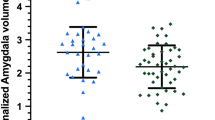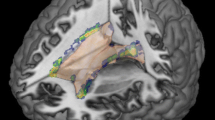Abstract
We evaluation of the role of determining the distribution of brain-stem, cerebellar and cerebral lesions in number and volume by MRI in determining the efficiency of treatment of multiple sclerosis (MS). We studied 24 patients diagnosed as having relapsing and remitting MS, of whom 12 received intravenous immunoglobulin G; a control group of 12 were given placebo. In a double-blind study, MRI was obtained initially and at 3, 6 and 9 months, and interpreted without knowledge of clinical findings, laboratory tests or treatment. The lesions were classified according to their distribution and evaluated qualitatively and quantitatively. Each patient was also examined clinically and scored according to the expanded disability status scale (EDSS) following every MRI examination. All patients in the treatment group showed significant improvement. The lesions decreased in both in size and number in all sites. In the control group lesions increased both in number and size in all sites, but only the increase between 3and 6 months was statistically significant. In both groups, significant apparent changes were detected in the cerebellum and brain stem. Volumetric evaluation was found to be more helpful than qualitative assessment.
Similar content being viewed by others
References
Isaac C, Li DK, Genton M, Jardine C, et al (1988) Multiple sclerosis: a serial study using MRI in relapsing patients. Neurology 38: 1511–1515
Kappos L, Stadt D, Rohrbach E, et al (1988) Gadolinium-DTPA-enhanced magnetic resonance imaging in the evaluation of different disease courses and disease activity in multiple sclerosis. Neurology 38 [Suppl.]: 255
Willoughby EW, Grochowsky E, Li DKB, Oger J, Kastrukoff LF, Paty DW (1989) Serial magnetic resonance scanning in multiple sclerosis: a second prospective study in relapsing patients. Ann Neurol 25: 43–49
Zhao GJ, Li DK, Wolinsky JS, et al (1997) Clinical and magnetic resonance imaging changes correlate in a clinical trial monitoring cyclosporine therapy for multiple sclerosis. J Neuroimaging 7: 1–7
Edan G, Miller D, Clanet M, et al (1997) Therapeutic effect of mitoxantrone combined with methylprednisolone in multiple sclerosis: a randomized multicentre study of active disease using MRI and clinical criteria. J Neurol Neurosurg Psychiatry 62: 112–118
Achiron A, Pras E, Gilad R, et al (1992) Open controlled therapeutic trial of intravenous immune globulin in relapsing-remitting multiple sclerosis. Arch Neurol 49: 1233–1236
Hahn AF, Bolton CF, Zochodne D, Feasby TE (1995) Intravenous Immunoglobulin treatment in chronic inflammatory demyelinating polyneuropathy (CIDP): a double-blind, placebo-controlled, crossover study. Brain 119: 1067–1078
Huber SJ, Paulson GW, Chakeres D, et al (1988) Magnetic resonance imaging and clinical correlations in multiple sclerosis. J Neurol Sci 86: 1–12
Poser CM, Paty DW, Scheinberg L, et al (1983) New diagnostic criteria for multiple sclerosis: guidelines for research protocols. Ann Neurol 13: 227–231
Grimaud J, Lai M, Thorpe J, et al (1996) Quantification of MRI lesion load in multiple sclerosis: a comparison of three computer-assisted techniques. Magn Reson Imaging 14: 495–505
Rovaris M, Filippi M, Calori G, et al (1997) Intra-observer reproducibility in measuring new putative MR markers of demyelination and axonal in multiple sclerosis: a comparison with conventional T2-weighted images. J Neurol 244: 266–270
Hedier I (1992) White matter disease in the elderly. Neuroimaging Clin North Am 2: 441–450
Achiron A, Barak Y, Goren M, et al (1996) Intravenous immune globulin in multiple sclerosis: clinical and neuroradiological results and implications for possible mechanisms of actions. Exp Immunol 104 [Suppl 1]: 67–70
Sorensen PS, Wanscher B, Jensen CV, et al (1998) Intravenous immunoglobuline G reduces MRI activity in relapsing multiple sclerosis. Neurology 50: 1273–1281
Molyneux PD, Fillipi M, Barkhof F, et al (1998) Correlations between monthly enhanced MRI lesion rate and changes in T2 lesion volume in multiple sclerosis. Ann Neurol 43: 332–339
van Walderveen MA, Lycklama à Nijeholt GJ, Ader HJ (2001) Hypointense lesions on T1-weighted spin-echo magnetic resonance imaging: relation to clinical characteristics in subgroups of patients with multiple sclerosis. Arch Neurol 58: 76–81
Fillipi M, Paty DW, Kappos L, et al (1995) Correlations between changes in disability and T2-weighted brain MRI activity in multiple sclerosis: a follow-up study. Neurology 45: 225–260
Khoury SJ, Guttmann CRG, Orav EJ, et al (1994) Longitudinal MRI in multiple sclerosis: correlation between disability and lesion burden. Neurology 44: 2120–2124
Author information
Authors and Affiliations
Corresponding author
Rights and permissions
About this article
Cite this article
Koçer, B., Yıldırım-Gürel, S., Talı, E.T. et al. The role of qualitative and quantitative MRI assessment of multiple sclerosis lesions according to their in evaluating the efficacy of intravenous immunoglobulin G. Neuroradiology 46, 287–290 (2004). https://doi.org/10.1007/s00234-003-1088-8
Received:
Accepted:
Published:
Issue Date:
DOI: https://doi.org/10.1007/s00234-003-1088-8




